Why is India widow burning case back in news after 37 years
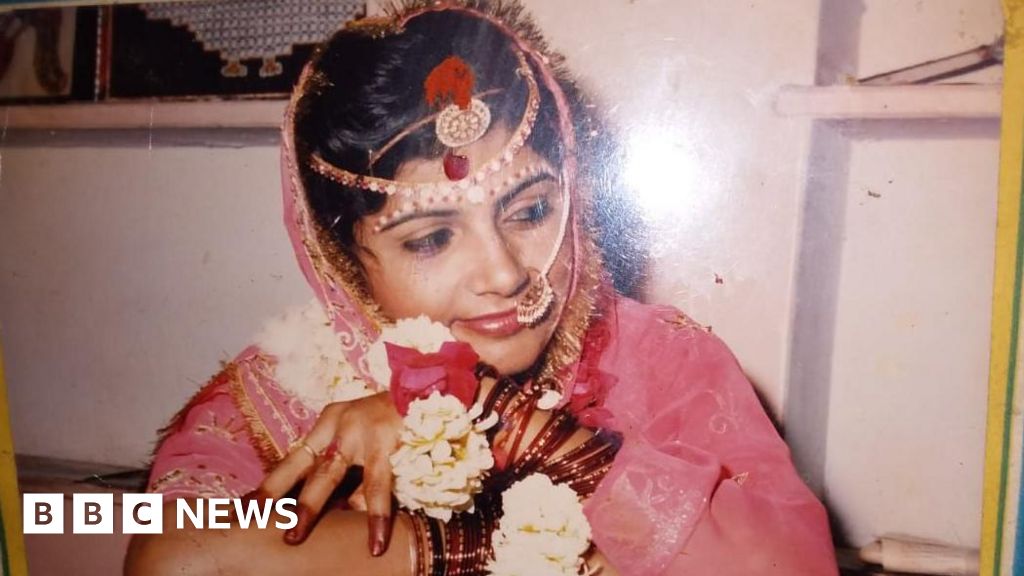
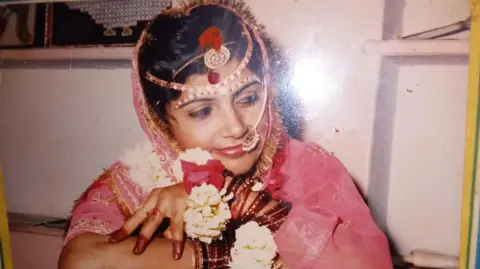 Mohar Singh Meena
Mohar Singh MeenaIt was a case that made headlines globally and led to widespread condemnation.
A teenaged widow was burned on her husband’s funeral pyre under the Hindu practice of sati 37 years ago.
Now Roop Kanwar’s story has returned to headlines in India after a court acquitted eight men accused of glorifying her death, in the last of the remaining cases in the grisly saga.
Sati was first banned in 1829 by the British colonial rulers, but the practice had continued even after India’s independence in 1947. Kanwar is recognised as India’s last sati.
The outrage over her death forced the Indian government to introduce a tough new law – Commission of Sati (Prevention) Act, 1987 – banning the practice and, for the first time, also its glorification. It mandated death or life term for those committing sati or abetting it. But over the years, everyone accused of involvement in Kanwar’s death and the glorification that followed has been cleared by courts.
- This report contains some distressing details
Last week’s order has also led to outrage, with women’s organisations and activists expressing concern that no-one has been held accountable over her death.
Fourteen women’s groups in Rajasthan have written a letter to Chief Minister Bhajan Lal asking him to ensure the government challenges the order in the high court and also makes all attempts to prevent glorification of sati. Coming after such a long delay, these acquittals could “reinforce a culture of sati glorification”, they wrote.
A lawyer acting for the eight accused told BBC Hindi that they were acquitted because “no evidence was found against them”.
I asked Rajasthan’s Justice Minister Jogaram Patel whether the government planned to appeal the decision.
“We haven’t yet received a copy of the judgement. We will examine it on its merits and demerits and then decide whether to appeal or not,” he told me.
When asked about why the government hadn’t appealed the earlier acquittals, he said those cases had happened before his time and he was not aware of the details.
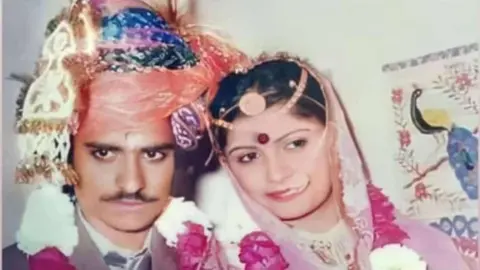 Getty Images
Getty ImagesThe death of the 18-year-old in Deorala village on 4 September 1987 was a huge public spectacle. Watched by hundreds of villagers, it was described as a blot on Rajasthan and India.
Her husband’s family and others from their upper-caste Rajput community said Kanwar’s decision had been in keeping with the tradition of sati and was voluntary.
They said she had dressed up in her bridal finery and led a procession around the village streets, before climbing into the pyre of Maal Singh, her husband of seven months. She then placed his head in her lap and recited religious chants while slowly burning to death, they added.
It was a claim contested by journalists, lawyers, civil society and women’s rights activists – and initially, even by Kanwar’s parents. They lived in the state capital, Jaipur, just two hours from the village, but learnt of their son-in-law’s death and their daughter’s immolation from the next day’s newspaper.
But they later said they believed their daughter’s act had been voluntary. Critics said the retraction had come under pressure from powerful politicians who used the incident to mobilise the Rajput community for “vote-bank politics”.
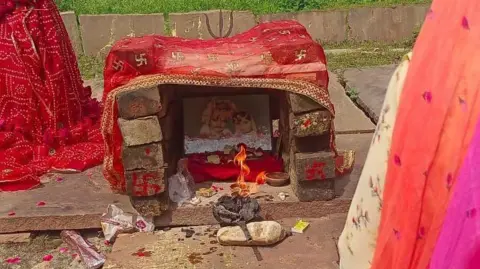 Mohar Singh Meena
Mohar Singh MeenaIn the days following Kanwar’s death, both sides held high-decibel protests.
The incident sparked widespread condemnation, with activists protesting for justice, criticism of the Congress-led state government, and a letter to the Rajasthan chief justice calling for a ban on celebrations.
Despite the court ban, 200,000 people attended a ceremony 13 days after Kanwar’s death, where framed photos and posters of her were sold, transforming Deorala into a profitable pilgrimage site. Shortly after, two separate reports concluded that Kanwar “was hounded by villagers to commit sati” and her immolation was “far from voluntary”.
Journalist Geeta Seshu, who visited the village as part of a three-member team three weeks after the incident, told the BBC that “the situation on the ground was tense and fraught”.
“The Rajput Sabha had taken over the entire place and the atmosphere was very charged. The spot where Roop had died was surrounded by sword-wielding young men. They were going around it in circles and it was very difficult for us to speak to eyewitnesses.”
But the trio still managed to get some testimonies from villagers that went into Trial by Fire, their damning fact-finding report.
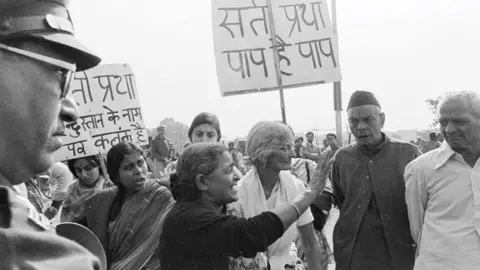 Getty Images
Getty Images“Preparations for the sati began immediately after Maal Singh’s body was brought to the village in the morning. Roop, who got an inkling of this, escaped from the house and hid in the nearby fields,” they wrote.
“She was found cowering in a barn and dragged to the house and put on the pyre. On her way, she is reported to have walked unsteadily surrounded by Rajput youths. She was also seen to have been frothing at the mouth” – suggesting that she had been drugged.
“She struggled to get out when the pyre was lit, but she was weighed down by logs and coconuts and youths with swords who pushed her back onto the pyre. Eyewitnesses reported to the police that they heard her shouting and crying for help,” the report added.
Ms Seshu says “one may couch it in the language of valour and sacrifice, but it was nothing but a horrific murder”.
She says when she met Kanwar’s parents and brothers, “they were angry and willing to fight. But they later changed their stance under pressure from community leaders”.
Her eldest brother Gopal Singh disputes this, and told the BBC they initially suspected foul play. “But our aunts who lived in Deorala told us that it was Roop’s decision. So, the elders in the family decided to drop it. There was no pressure on us.”
Mr Singh later went on to join the Sati Dharma Raksha Samiti – a committee formed to valorise Kanwar’s immolation – and became its deputy chief. After its glorification was made illegal, the group dropped sati from its name. He said he had spent 45 days in prison on charges of sati glorification but was acquitted in January 2004 for “lack of evidence”.
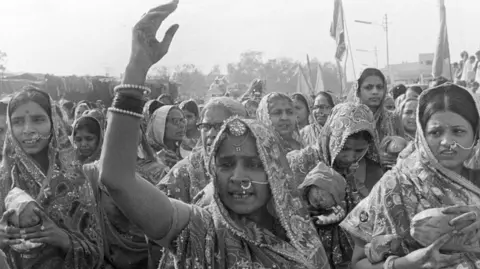 Getty Images
Getty ImagesMs Seshu says the general consensus when they visited the village after the incident was that “sati happens, women do it. The police and administrations were so complicit in the celebrations that no genuine efforts were made to collect evidence or fix responsibility”.
What was most tragic, she adds, was that Kanwar’s death was used by the Rajput community as a mobilising force to benefit them politically and to make money.
“The supporters wanted to build a temple at the site but the new law which banned sati glorification also barred construction of temples or collection of money from visitors. Now this acquittal could open the gates for a revival of religious tourism to the place.”
It’s a legitimate concern.
In Deorala, the spot at the edge of the village where Kanwar died, still attracts some visitors all these years later.
A photograph taken a year back shows a family lighting a lamp before a framed picture of Kanwar and her husband, placed under a small brick structure draped with a red and gold scarf.
But despite Kanwar’s deification, chances of justice for India’s last sati remain dim.
Follow BBC News India on Instagram, YouTube, Twitter and Facebook.
#India #widow #burning #case #news #years
News plays a pivotal role in our lives by keeping us informed and connected to the world. It serves as a critical source of information, offering updates on current events, politics, economics, science, and more. Through news, we gain awareness of global issues and local developments, helping us make informed decisions in our personal and professional lives. News also fosters discussion and debate, encouraging critical thinking and perspective-taking. Moreover, it promotes transparency and accountability among governments, businesses, and other institutions. In a rapidly changing world, staying updated with the news enables us to adapt to new challenges and opportunities, shaping our understanding of the complexities of society. Ultimately, news is not just about information; it empowers us to participate actively in the world around us, contributing to a more informed, engaged, and responsible global citizenry.
Health is fundamental to our well-being and quality of life, making it an essential aspect of daily existence. It encompasses physical, mental, and emotional aspects, influencing our ability to function effectively and enjoy life fully. Prioritizing health allows individuals to maintain optimal physical fitness, reducing the risk of diseases and promoting longevity. Mental health, equally crucial, affects our cognitive abilities, emotional stability, and overall happiness. Investing in preventive healthcare through exercise, balanced nutrition, and regular medical check-ups helps in early detection of potential health issues, ensuring timely intervention and treatment. Beyond individual benefits, a population’s health impacts societal productivity and economic stability. Governments and organizations worldwide emphasize public health initiatives to address pandemics, health disparities, and promote overall well-being. Ultimately, health serves as the foundation upon which we build our lives, influencing our ability to pursue goals, nurture relationships, and contribute meaningfully to society.
Money plays a crucial role in our lives as a means of financial security and freedom. It enables us to meet basic needs such as food, shelter, and healthcare, while also providing opportunities for education, travel, and personal growth. Beyond material comforts, money facilitates social connections and experiences that enrich our lives. It empowers individuals to invest in their futures, whether through savings, investments, or entrepreneurial ventures, thereby fostering economic stability and growth. However, the pursuit of wealth should also be balanced with ethical considerations, as money can influence relationships and societal dynamics. Responsible management of finances is key to achieving long-term goals and mitigating financial stress. Ultimately, while money is a tool for achieving aspirations and fulfilling desires, its true value lies in how it is utilized to improve both personal well-being and the broader community.
Earning Easy Money in 2024: Opportunities and Considerations 💸
In 2024, the landscape of earning easy money presents diverse opportunities, albeit with considerations. The digital age offers platforms for freelancing, online trading, and e-commerce, allowing individuals to leverage skills and creativity for financial gain. Cryptocurrency investments continue to allure with potential for quick profits, yet they entail high volatility and risk. Moreover, the rise of the gig economy enables flexible work arrangements through apps and websites, offering quick payouts but often without job security or benefits. Passive income streams such as rental properties and investments in stocks or bonds remain viable, but demand initial capital and ongoing management. Amid these options, caution is essential to avoid scams and unsustainable ventures promising overnight success. Ultimately, while the allure of easy money persists, informed decisions, diligence, and a long-term perspective are crucial for sustainable financial growth and security in the dynamic year ahead.






